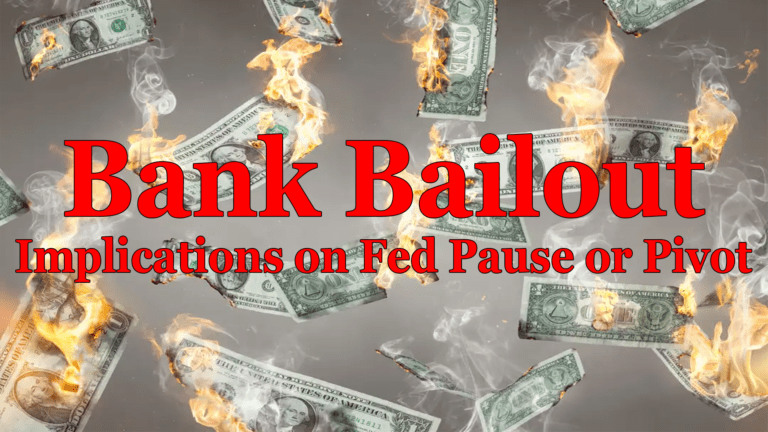Market and Economy
Diligence is the mother of good luck
Benjamin Franklin

Video: Federal Debt Downgrade Highlights US Government Fiscal Problems
US Debt has been downgraded from AAA to AA+ by Fitch. While credit risk is probably quite low, interest rates and inflation risk are going to become more apparent over the next decade.

Video: Great but Long Discussion of Economy, Inflation, Deficits, Energy and Gold by Luke Gromen.
Great but long discussion by an outside source.

Economic and Market Review June 2023
Economic and Market Review June 30, 2023 Overview Equity markets reacted to uncertainty in June as major indices saw an increase in volatility. Earnings continue to be a critical focal point as companies struggle to maintain elevated prices while consumer confidence has begun to erode. The Federal Reserve has essentially

Video: QT resuming, Credit Crunch underway, US Government Debt Squeezing out Private Sector.
• Markets had a strong June based on 7 stocks and pushed the S&P500 up almost 16% on a year-to-date basis. The rest of the market is only up around 3%.
• In March, regional banks crises kicked off with big losses on US government bonds and deposit flight. The crises will probably move to commercial real estate which is being hit by increased vacancies and higher interest rates. QT reversal was executed to slow crises. This has worked so far but unlikely to stem crises.
• My caution since January has proven wrong as QT reversal, investment sentiment and already existing liquidity drove market higher.
• Behind schedule on QT, but the Fed is still staying the course. The economy is weakening.
• Federal deficit too high at $32 Trillion, the debt ceiling debacle highlighted this. Private spending and investment will be squeezed out by federal government borrowing.

Economic and Market Review May 2023
Economic and Market Review May 31, 2023 Overview Congress passed legislation during last-minute negotiations to avert a default on the nation’s debt. The suspension on the U.S. government’s $31.4 trillion debt ceiling is temporary until lawmakers finalize legislation to fund ongoing federal obligations. The impasse on the debt ceiling added

Video: Debt Ceiling Theatre – US Debt Crises in the Future
Reducing Social Security and Medicare politically impossible. The Federal Reserve restarting QE (Quantitative Easing) and buying the US debt to keep rates down. QE is the most likely choice and will be wildly inflationary. Recession seems to have started in the second quarter. QE will most likely be used to restart the economy once the recession has caused enough pain.

Economic and Market Review April
Economic and Market April April 30, 2023 Continuing Weakness in Banking Sector Concern over additional bank failures has created ongoing uncertainty for equity and bond markets, as the collapse of First Republic Bank this past month has become the second-largest bank failure ever, with $229 billion in assets and over

Video: Caution not Complacency. Debt Crises, First Republic, Credit Crunch, Fed to 5.25%, QT, Down Earnings
Treasury Secretary Janet Yellen indicated the US Federal Government might be out of money by June 1 requiring extraordinary measures. This means not all expenses are paid unless Congress acts to increase the debt ceiling. The Debt Crises is a result of out of control spending by the Federal Government starting at the Great Financial Crises in 2008 and leaping further during COVID. Nearly $32 Trillion in US Federal debt, $35 Trillion in unfunded Medicare liability and $22 Trillion in unfunded Social Security liability. This is in comparison to total US Economy of $25 Trillion in 2022.

Video: QT Restart, Credit Crunch. $400 Billion Added to the Balance Sheet After SVB Failure
• SVB (Silicon Valley Bank) crises created a $550 billion of deposit withdrawals from small and medium banks creating a credit crunch.
• The Fed announced the BTFP (Bank Term Funding Program). The Fed provides one year loans to all depository institutions in exchange for treasuries at par value even when market value has declined.
•This ballooned the balance sheet from the QT (Quantitative Tightening) low of $8.34 trillion on March 8th, to $8.73 trillion on March 22nd.
•The credit crunch is just beginning.

Economic and Market Review March
Economic and Market Review March 31, 2023 Bank Failures May Alter Fed’s Course The failure of two regional banks unsettled equity and fixed-income markets globally in March. Financial contagion risks were at the forefront of the financial markets as the closure of Silicon Valley Bank and Signature Bank fostered turmoil

Video: The Fed increased its Balance Sheet and paused QT. Banks are bad investments.
The Fed (The Federal Bank) increased its Balance Sheet by $400 Billion through specialized lending to banks. Silicon Valley Bank (SVB) problems started with big losses on the bond portfolio that metastasized into a run on the banks deposits. Banks have $620 Billion in unrealized losses so this is a wide spread problem. Small and medium sized banks are losing deposits which will result in tightening credit and help push the economy into a recession.
QT (Quantitative Tightening) has been on pause with only $6 billion reduction in treasury bond portfolio versus $74 Billion per plan. $90 billion matured on March 31st. The question will be did the Fed roll them or restart QT. Unpredictable environment.
Banks are bad investments. My Positions in Citigroup and US Bank which I had bought in December were sold as SVB crystalized how incompetent banks are and that banks have historically been bad investments.

Video: Banking Crises Creates Bank Bailout, Impact on QT (Quantitative Tightening), FFR Increases, and CPI
Banking Crises Creates Bank Bailout
1. All deposits even over $250,000 are covered by FDIC at Silicon Valley Bank and Signature Bank. Implied guarantee for all uninsured deposits in the banking industry. About $7 Trillion in total.
2. Banks can borrow against their portfolio at par even if the market price is 70, 80 or 90.

